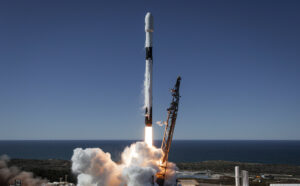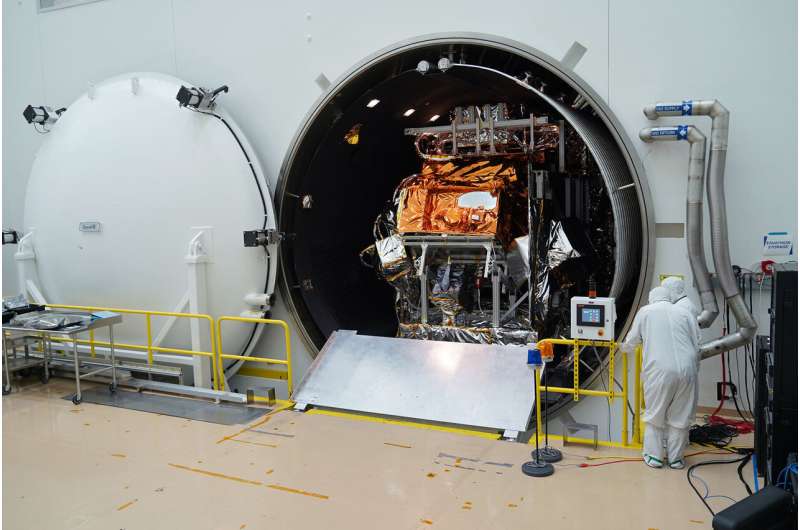Getting SSA off the ground
Friday, 17 June 2022 13:43
Investors are funding orbital solutions for tracking space objects.
The post Getting SSA off the ground appeared first on SpaceNews.
Webb's mid-infrared spectroscopy will reveal molecules, elements
Friday, 17 June 2022 12:18
Week in images: 13-17 June 2022
Friday, 17 June 2022 12:03
Week in images: 13-17 June 2022
Discover our week through the lens
SCEYE HAPS ascends to stratosphere demonstrates ability to stay over area of operation
Friday, 17 June 2022 11:45 Sceye, a manufacturer of High-Altitude Platform Stations (HAPS), announced that it reached the stratosphere with the aim of demonstrating the ability to stay over an area of operation for months at a time using renewable energy sources.
The milestone test launch, which is using patented solar and battery power, puts Sceye on track to expand internet access to remote populations, monitor gr
Sceye, a manufacturer of High-Altitude Platform Stations (HAPS), announced that it reached the stratosphere with the aim of demonstrating the ability to stay over an area of operation for months at a time using renewable energy sources.
The milestone test launch, which is using patented solar and battery power, puts Sceye on track to expand internet access to remote populations, monitor gr Airbus built MEASAT-3d communications satellite ready for launch
Friday, 17 June 2022 11:45 The Airbus built MEASAT-3d telecommunications satellite is in Kourou, French Guiana and is ready for its launch on an Ariane 5 on 22 June 2022.
MEASAT-3d is the 57th E3000 satellite built by Airbus and will be positioned at the 91.5E orbital slot and collocated with MEASAT-3b, also built by Airbus.
This new satellite will significantly enhance broadband speeds of up to 100 Mbps in ar
The Airbus built MEASAT-3d telecommunications satellite is in Kourou, French Guiana and is ready for its launch on an Ariane 5 on 22 June 2022.
MEASAT-3d is the 57th E3000 satellite built by Airbus and will be positioned at the 91.5E orbital slot and collocated with MEASAT-3b, also built by Airbus.
This new satellite will significantly enhance broadband speeds of up to 100 Mbps in ar Northrop Grumman runs Laser Communication Demonstration for Tranche 1 constellation
Friday, 17 June 2022 11:45 Northrop Grumman Corporation has announced the successful ground demonstration of a secure networked laser communications system for proliferated-LEO constellations supporting the U.S. military.
Performed for SDA leadership, the demonstration validated compatibility between commercially developed laser communication and secure U.S. government encryption hardware, providing a baseline for N
Northrop Grumman Corporation has announced the successful ground demonstration of a secure networked laser communications system for proliferated-LEO constellations supporting the U.S. military.
Performed for SDA leadership, the demonstration validated compatibility between commercially developed laser communication and secure U.S. government encryption hardware, providing a baseline for N China's deep space exploration laboratory starts operation
Friday, 17 June 2022 11:45 China's deep space exploration laboratory has started operations, the China National Space Administration (CNSA) said Tuesday.
Co-established by the CNSA, Anhui Province and the University of Science and Technology of China, the laboratory is headquartered in Hefei, capital city of Anhui.
It has completed various preparatory work and entered a new stage of substantial operation and c
China's deep space exploration laboratory has started operations, the China National Space Administration (CNSA) said Tuesday.
Co-established by the CNSA, Anhui Province and the University of Science and Technology of China, the laboratory is headquartered in Hefei, capital city of Anhui.
It has completed various preparatory work and entered a new stage of substantial operation and c German radar satellite TerraSAR-X - 15 years in space and still in perfect shape
Friday, 17 June 2022 11:45 Fifteen years - who would have thought it? The German radar satellite TerraSAR-X, which was launched from the Baikonur Cosmodrome in Kazakhstan at 08:14 local time on 15 June 2007, was originally designed to last five and a half years - until the end of 2012. It has been delivering data of outstanding quality ever since, regardless of weather conditions, cloud cover and daylight levels. The scie
Fifteen years - who would have thought it? The German radar satellite TerraSAR-X, which was launched from the Baikonur Cosmodrome in Kazakhstan at 08:14 local time on 15 June 2007, was originally designed to last five and a half years - until the end of 2012. It has been delivering data of outstanding quality ever since, regardless of weather conditions, cloud cover and daylight levels. The scie NASA, ESA finalize agreements on climate, 1 cooperation
Friday, 17 June 2022 11:45 NASA Administrator Bill Nelson and ESA Director General Josef Aschbacher signed two agreements Wednesday at the ESA Council meeting in Noordwijk, Netherlands, further advancing the space agencies' cooperation on Earth science and Artemis missions.
"With these two agreements, NASA and ESA are strengthening the relationship on two of our agencies' primary mission areas: Artemis and Earth sci
NASA Administrator Bill Nelson and ESA Director General Josef Aschbacher signed two agreements Wednesday at the ESA Council meeting in Noordwijk, Netherlands, further advancing the space agencies' cooperation on Earth science and Artemis missions.
"With these two agreements, NASA and ESA are strengthening the relationship on two of our agencies' primary mission areas: Artemis and Earth sci Evan Leppink: Seeking a way to better stabilize the fusion environment
Friday, 17 June 2022 11:45 "Fusion energy was always one of those kind-of sci-fi technologies that you read about," says nuclear science and engineering PhD candidate Evan Leppink. He's recalling the time before fusion became a part of his daily hands-on experience at MIT's Plasma Science and Fusion Center, where he is studying a unique way to drive current in a tokamak plasma using radiofrequency (RF) waves.
Now, a
"Fusion energy was always one of those kind-of sci-fi technologies that you read about," says nuclear science and engineering PhD candidate Evan Leppink. He's recalling the time before fusion became a part of his daily hands-on experience at MIT's Plasma Science and Fusion Center, where he is studying a unique way to drive current in a tokamak plasma using radiofrequency (RF) waves.
Now, a Astronomers renew concerns about Starlink satellite brightness
Friday, 17 June 2022 10:56
As SpaceX gears up for another launch of Starlink satellites, astronomers are concerned the company maybe backsliding in its efforts to reduce the brightness of those satellites.
The post Astronomers renew concerns about Starlink satellite brightness appeared first on SpaceNews.
Earth from Space: Glacier Bay, Alaska
Friday, 17 June 2022 07:00
Part of the Glacier Bay National Park and Preserve, which lies along the coast of southeast Alaska, is featured in this image captured by the Copernicus Sentinel-2 mission.
Astronomers want “strong finish” for SOFIA
Friday, 17 June 2022 05:57
The organization that operates an airborne astronomical observatory that NASA is shutting down this year wants to end the project on a high note.
The post Astronomers want “strong finish” for SOFIA appeared first on SpaceNews.
House Armed Services chairman calls on Space Force to change how it buys launch services
Friday, 17 June 2022 00:50
House Armed Services Committee Chairman Adam Smith (D-Wash.) in a draft version of the 2023 National Defense Authorization Act pushes for changes in military launch services procurement.
The post House Armed Services chairman calls on Space Force to change how it buys launch services appeared first on SpaceNews.
NASA completes critical testing milestone for NOAA's JPSS-2 satellite
Thursday, 16 June 2022 20:01
The Joint Polar Satellite System-2 satellite, or JPSS-2, has cleared a critical testing milestone, bringing it a step closer to launch. Last week, the National Oceanic and Atmospheric Administration's polar-orbiting satellite emerged from the chamber after completing its thermal vacuum testing. This test is meant to show that the spacecraft and all of its instruments will perform successfully when exposed to the harsh environments of space.
"I can absolutely say with 100% certainty that the observatory is working great," said JPSS Flight Project Manager Andre Dress at NASA's Goddard Space Flight Center in Greenbelt, Maryland. "All the instruments are performing great, and we're going to meet all our requirements—and then some."
JPSS-2, the third satellite in the Joint Polar Satellite System series, will provide data that improves weather forecasts and advance our understanding of extreme weather and climate change.
